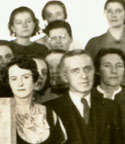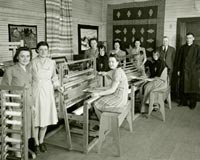 |
 |
|
During the Second World War
Searle Grain Company “BY THE FARM WOMEN OF QUÉBEC”at the Canadian Seed Growers Association in Ottawa. In Québec City he met Bériau who was delighted with the opportunity to tell of his work and achievements, touring the school and local farms.With Bériau present, Major Strange presented to Augustus Searle a plan for a weaving program for the Western farmwomen, which was approved. Renée Bériau Sixteen weaving centers were set up in towns where the SGC operated, which assured the help of the local agent for the school. Each school had 16 students divide into a morning and afternoon classes, which ran for six weeks tuition free. All the basic techniques were taught. Looms could be purchased for $60 cash or deferred payment of $5 a month at no interest. If the weavers at any time changed their minds, the looms would be bought back. Of the 600 looms sold only one was returned.(23) Weaving classes took place in church halls, schools, convents and even school train (A class room in a rail car). Renee found train travel very uncomfortable with no heat in winter; her sandwiches she brought froze. Often the train waited hours for the troop trains to pass. Small town hotels usually had no indoor plumbing and she would chair brace the door to prevent the drunken men from trying to enter her room. The SGC weaving brochure stated "... Bériau is undoubtedly the greatest authority on the American continent, and one of the great authorities of the world...”(23) The Foundation Set Today, Canadian artisans enjoy a special place in the society due to Bériau. “… Whose magic wand we attribute the revival of spinning, weaving and other crafts for the decorative furnishing of rural homes in the Province of Québec”24 Bériau truly wove together all those who helped produce better materials and equipment, helped provide consultation on better methods, taught their craft to anyone who wished to learn, and through their leadership in corporations, religious institutions and government sector promoted, funded and provided the logistic support for these major programs. All this helped create an environment and culture that continues to promote and make all types of crafts, from a simple blanket on a bed to a fiber arts tapestry that is exhibited in a gallery. The artist and the artisan, or if you prefer, craftsperson, are given the same respect in Canadian Society. A report was presented to The Embroiderers’ Guild of America, Inc. January 8, 2003. This edited article version was presented was published the December 2004 edition of Needle Arts. © Jean-Paul Picard Jr. 2003
References for this site Top of this page
©Jean-Paul Picard 2001-09 ALL RIGHTS RESERVED |
